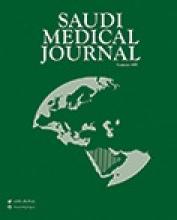To the Editor
The study is based on a questionnaire that has its limitations as mentioned by Algethami et al,1 therefore the results should be interpreted cautiously. Here are some points to be mentioned:
1) Conclusions based on questionnaire are not necessarily scientifically sound.
2) The word oculo-visual was mentioned twice in the manuscript. It is irrelevant to the content of the paper as the authors were looking basically at the refractive errors as a cause of reduction of vision and did not address squint or other ocular diseases.
3) The authors must elaborate on the importance of early screening and diagnosis for prevention of amblyopia in this age group. This is a point of great importance in the pediatric age group and is the hallmark for vision screening in the pediatric age group.
4) The cause of vision reduction in the students was not addressed by the authors.
5) There could have been a stronger manuscript if there were more elaborative details of eye examination.
6) Visual acuity defects might be attributed to the patients not understanding the test due to their intellectual limitations.
7) The method used for visual assessment was not specified and could have been different at different centers therefore affecting the final conclusions.
8) The screening process was performed by different persons (school teachers, nurses, and so on). Thus, inter-personal variations might affect the final results.
Reply from the Author
We would like to thank Dr. Alhemidan for her comments on our recently published article. The importance of interpreting the results of this survey with caution was highlighted. This is a well-known limitation for all questionnaire-based articles, which are dependent on self-report.
Subjects with intellectual disability are at an increased risk of oculo-visual disorders, including refractive errors, strabismus, and cataracts.2-5 The use of the term “oculo-visual disorders” was criticized as irrelevant in our article. The authors believe this terminology is applicable in the given context for several reasons. Firstly, causes of visual impairment have not been explored in our current study. Secondly, even if the authors focused on refractive errors as the main cause of preventable visual impairment, in our article, reporting ‘low vision aids’ and patients with ‘visual impairment recorded as their primary disability’ can very well be due to the many other causes of visual impairment necessitating the use of a broader term.
We concur with the importance of early screening for the prevention of amblyopia in special education needs (SEN) children. The authors explicitly mentioned, both in the introduction and conclusion sections, the importance of early detection and that vision screening should be made mandatory at certain ages (for example, as a prerequisite for school registration), allowing for early detection.
Several points raised by Dr. Alhemidan were quite interesting to investigate, however, not the primary objective of our study. These included the causes of visual impairment in the target population, different methods of visual acuity assessment used by the SEN schools, and the inter-personal variations of the different personnel involved in the screening process. This study sought primarily to evaluate the current status of vision screening and eye care in SEN schools in the Western Region of Saudi Arabia. Based on the results of our study, reflecting poor vision care status of intellectually disabled individuals in our region (Phase 1), projects to explore possible causes of visual impairment in these individuals in the Western Region are currently underway by our team (Phase 2). Variability amongst different practitioners using different visual acuity methods is a practical issue to explore. Preferential looking techniques, which are reliable in detecting amblyopia in intellectually disabled individuals who cannot complete optotype acuity tests,6-8 allow for higher rate of testability and make it less dependent on the children’s cooperation for vision assessment.
Regarding the vision screening process, differences between school staff members (nurses, teachers, pediatricians, and so on) who perform vision assessment will most likely exist given their different educational backgrounds and training exposure. Again, although important, this has not been addressed in our study due to practicality issues and to enhance response rates. We believe that this study paves the way for future studies to explore all the above-mentioned areas to help develop strategies to improve vision screening programs for children with SEN.
Lina Raffa
Department of Ophthalmology King Abdulaziz University Hospital Jeddah, Kingdom of Saudi Arabia
- Copyright: © Saudi Medical Journal
This is an open-access article distributed under the terms of the Creative Commons Attribution-Noncommercial-Share Alike 3.0 Unported, which permits unrestricted use, distribution, and reproduction in any medium, provided the original work is properly cited.






